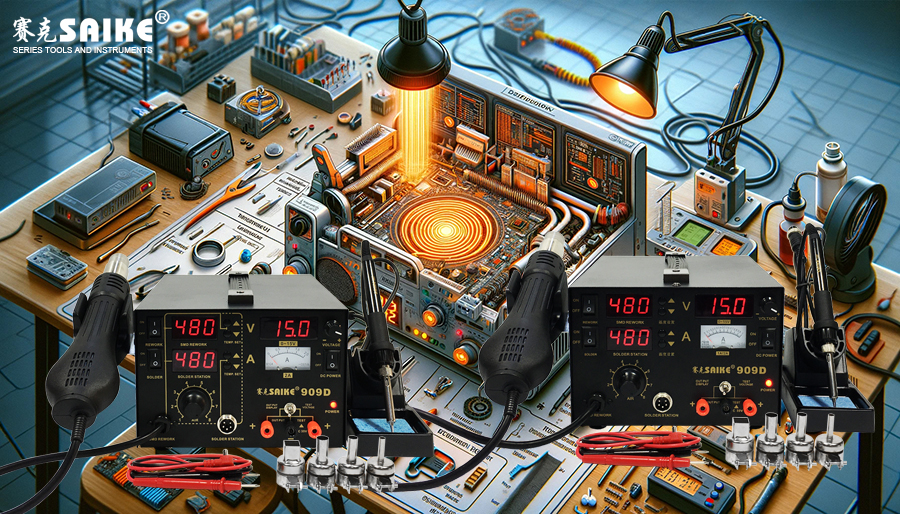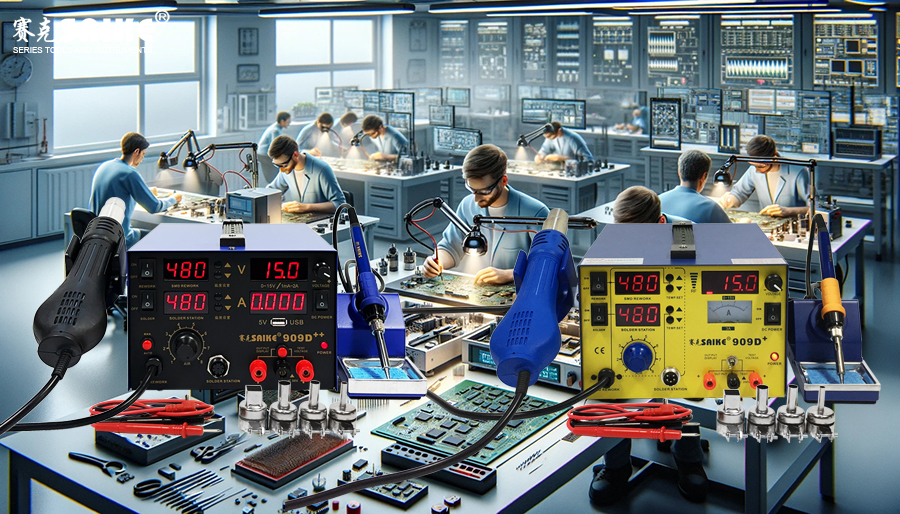
SK-YJ000RFSHY-KP 100013
Hot air rework stations are widely used tools in electronic repair and production, primarily functioning to heat components through hot air for soldering and desoldering purposes. However, the heating element in hot air rework stations is prone to failures, affecting normal operations. This article provides a detailed introduction to the diagnosis and maintenance methods for heating element failures in hot air rework stations.
I. Working Principle of the Heating Element in Hot Air Rework Stations
The heating element in a hot air rework station heats the air through an electric heating element, which is then blown out by a fan to heat the target component. The main components include the electric heating element, fan, temperature controller, and power supply system.
1.Electric heating element: Converts electrical energy into heat, typically a ceramic heater or resistance wire.
2.Fan: Provides airflow to blow the heated air towards the work area.
3.Temperature controller: Regulates and monitors the output temperature to ensure precise heating.
4.Power supply system: Provides the necessary electrical energy to drive the entire device.
II. Common Fault Phenomena and Cause Analysis
Various faults may occur during the use of the heating element in hot air rework stations. Common fault phenomena and their possible causes are analyzed below:
1.The heater does not heat up:
– Power failure: Check if the power connection is normal.
– Damaged heating element: The electric heating element may be aged or burned out.
– Temperature controller failure: The temperature sensor may be malfunctioning, or the control circuit board may be damaged.
2.The fan does not rotate:
– Motor failure: The fan motor may be burned out or stuck.
– Power issue: The power connection to the fan may be interrupted.
– Control circuit problem: The circuit controlling the fan may be damaged.
3.Unstable temperature:
– Temperature sensor failure: The sensor may be damaged or poorly connected.
– Controller failure: The temperature control circuit may be unstable or damaged.
– Unstable wind speed: The fan is not working properly, affecting airflow stability.
III. Fault Diagnosis Steps
Before proceeding with repairs, it is necessary to conduct a detailed fault diagnosis of the hot air rework station. The specific steps are as follows:
1.Preliminary inspection:
– Check the power supply: Ensure that the power plug is well-connected, and the power switch is functioning normally.
– Check the appearance: Examine the device for any visible damage, such as burn marks or loose connections.
2.Functional testing:
– Test heating function: Start the device, observe if the heating element heats up, and if the temperature rises.
– Test fan function: Check if the fan is operating normally and the airflow is unobstructed.
3.Internal inspection:
– Check the electric heating element: Use a multimeter to measure the resistance value of the electric heating element to determine if it is damaged.
– Check the fan motor: Test the resistance and operating status of the fan motor.
– Check the control circuit: Examine the components on the control circuit board for any damage or solder joint detachment.
IV. Fault Repair Methods
Perform corresponding repair operations based on the diagnosis results:
1.Replace the electric heating element:
– Turn off the power and disassemble the outer casing of the hot air rework station.
– Locate the damaged electric heating element and disconnect the wires.
– Install a new electric heating element, connect the wires securely, and ensure a firm connection.
– Reassemble the outer casing, power on, and test.
2.Repair or replace the fan:
– Check the power connection of the fan to ensure it is well-connected.
– If the fan motor is damaged, disassemble the old motor and install a new one.
– Ensure that the fan bearings are well-lubricated to avoid fan seizure due to bearing friction.
3.Temperature controller repair:
– Check the connection of the temperature sensor to ensure it is functioning properly.
– Replace a damaged control circuit board or repair faulty components on the board.
– Recalibrate the temperature controller to ensure the temperature display matches the actual temperature.
V. Maintenance and Servicing
To extend the service life of the hot air rework station and reduce the frequency of failures, regular maintenance and servicing are recommended:
1.Regular cleaning: Regularly clean the device’s surface and interior to prevent dust and debris from entering.
2.Check connections: Periodically inspect power cords and internal connections to ensure they are secure and not loose or aged.
3.Lubricate the fan: Regularly lubricate the fan bearings to ensure smooth fan operation.
4.Calibration of temperature controller: Regularly calibrate the temperature controller to ensure the accuracy of temperature control.
VI. Conclusion
The diagnosis and maintenance of hot air soldering station heater failures require a certain level of technical knowledge and experience. By understanding the working principle of the heater, mastering common failure phenomena and causes, and following scientific troubleshooting steps for inspection, problems can be effectively identified and repaired. At the same time, regular maintenance is crucial to extend the equipment lifespan and improve work efficiency. It is hoped that this article will be helpful to the majority of electronic maintenance personnel in dealing with hot air soldering station failures.


